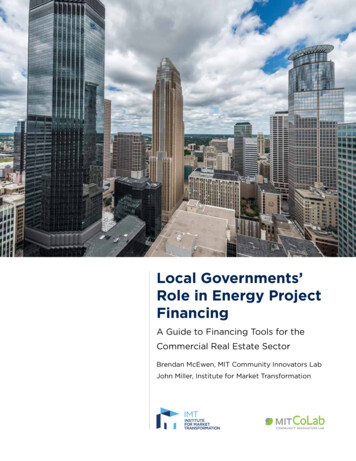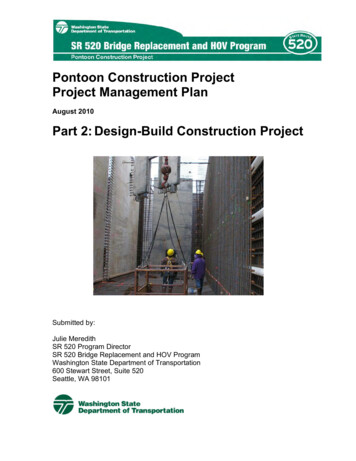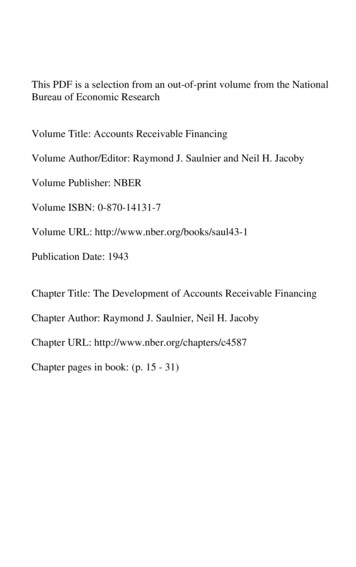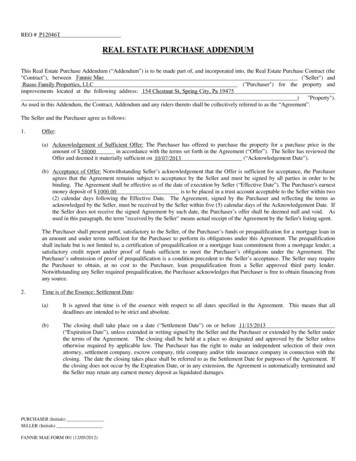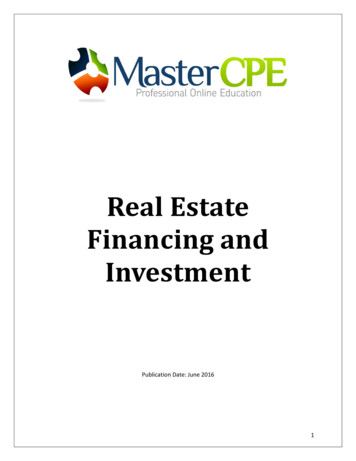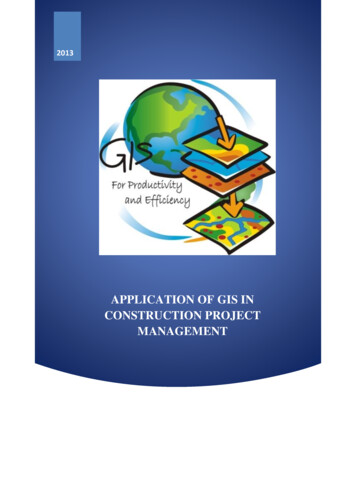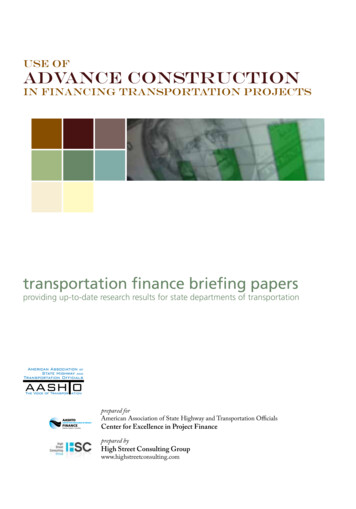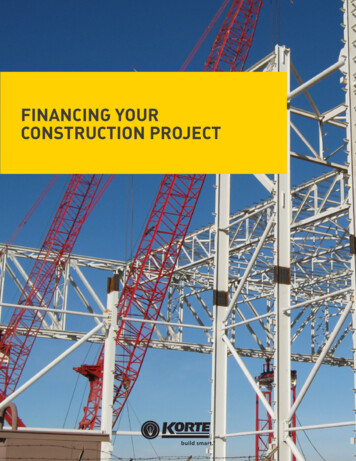
Transcription
FINANCING YOURCONSTRUCTION PROJECT
TABLE OF CONTENTSPART 1: THE BASICS OF CONSTRUCTION FINANCE. 4PART II: SECURING FINANCING. 12PART III: TYPES OF FINANCING AVAILABLE. 14PART IV: FUNDING THE BIGGEST PROJECTS. 202 THE KORTE COMPANY
OVERVIEWAt The Korte Company, we’ve built for some of our nation’sgreatest visionaries. Innovators with ideas that needed aplace to call home. In our experience, securing smarterconstruction financing has been one of the primarychallenges they’ve faced. This white paper will give you keyknowledge to help overcome this challenge so your big ideascan keep moving.We’ve written this guide primarily for owners in the privatesector who are unfamiliar with construction finance and needto secure funding. In it, we cover five primary topics: The basics of construction finance How to get financing and prepare documentation forlenders The kinds of financing available and strategies forsecuring funds The advantages and disadvantages of different financingstrategies Specialty financing sources for the biggest projects3 THE KORTE COMPANY
PART 1:THE BASICS OFCONSTRUCTION FINANCE
THE BASICS OF CONSTRUCTION FINANCEIn this section, we cover the way construction loans work, project costs and thekey numbers that lenders evaluate.HOW CONSTRUCTION FINANCING WORKSThe first thing to know about construction finance is you actually need to fundtwo different loan periods, each with different risk levels. Most owners securetwo loans, one for each period. The first is the period during construction,funded with a construction loan. The second is the period after construction,funded with a permanent loan, AKA a takeout loan.Typically, owners structure financing through a real estate holding company,which holds the construction property and the loans to limit risk for ownersand their businesses.CONSTRUCTION LOANSA construction loan pays for up-front project costs. In most cases, you’ll makeinterest-only payments during construction, meaning once construction iscomplete, you’ll still have to pay the full principal amount of the loan plusinterest. The faster you complete construction, the less interest you’ll have topay, or the lower your cost of capital.STABILIZATIONOnce construction is complete, you need your facility to reach what’s calledstabilization, which happens when your facility is worth more than the initialcost of construction. Lenders consider your finished property quality collateral,so lending to you is less risky. Depending on the type of property you build, itmay not achieve stabilization until it’s reached a specified level of occupancy orrental income.5 THE KORTE COMPANY
STABILIZATIONproperty value initial cost of constructionPERMANENT LOANSOnce your property has achieved stabilization, you’ll get a permanent loan witha lower interest rate to pay off the construction loan. Then, you’ll pay back thepermanent loan, which typically has a set repayment structure and schedule.In some cases, you can take out a combination loan, which covers both theconstruction period and the post-construction period. In combination loans,conditions for stabilization are defined up-front, and a pre-negotiated interestrate and payment plan kick in once stabilization is achieved.The most favorable option would usually be a low-interest balloon loan, inwhich owners make low monthly payments (possibly interest-only) for aspecified time period and make a large final payment. But because of today’stight financial markets, balloon loans are difficult to attain.FINANCING BASICS: RISK, COLLATERAL AND VALUELending money for construction, particularly new construction, is riskierthan many other types of lending. For starters, construction is a complexundertaking with many potential pitfalls. It requires a strong ownership groupwith a defined plan for finished facilities. And it demands a skilled project teamto deliver your build on-time, on-budget and to high quality standards. Lenderswant to know your project will succeed, so they’ll take measures to evaluateyour project’s viability and their risk.6 THE KORTE COMPANY
PASSING THE PROFIT TEST TO GET A CONSTRUCTION LOANWhen evaluating potential borrowers for a construction loan, lenders startwith the profit test, which determines whether or not your finished facility willbe worth more than cost of your project — particularly if you plan to use yourfacility as loan collateral.Lenders will evaluate how much relevant experience your ownership group hasand the experience of your project team. And they’ll consider how invested youare in your project using two measures:1. The loan-to-value ratio2. The loan-to-cost ratioLOAN-TO-VALUE RATIO amount of money borrowedvs.estimated value of facilityLOAN-TO-COST RATIO amount of money borrowedvs.cost of project7 THE KORTE COMPANY
Today, most lenders don’t usually finance more than 75 percent of a project’svalue. Depending on the job, the threshold may be lower than 75 percent.The lower the loan-to-value and loan-to-cost ratios, the less risk your lenderis taking and the less need you have for additional collateral or personalguarantees.COLLATERAL AND GUARANTEESIn almost every construction loan, owners use their facility as collateral. Ifowners default on the loan, the lender gets the facility. Collateral may also beland. Depending on the project, land may be a bigger portion of collateral. Thereason? Some properties are easier for a lender to sell or lease than others— e.g. an office space can be rented to many tenants, while a gas station haslimited use.Almost always — particularly given today’s tight credit environment — lenderswill require your ownership group to provide personal guarantees, whereinyour investors agree to personally pay back the loan if the project fails.Lenders will evaluate the net worth of your ownership group and want to seethat it’s at least equal to the amount of the loan. The official term for this is the“loan-size ratio.”Today, borrowers usually must show ALL of their assets and liabilities,providing an annual update to lenders. Personal guarantees can be joint andseveral. And they can be capped at a certain amount.8 THE KORTE COMPANY
DEFINING STABILIZATION: HOW LENDERSVALUE YOUR PROPERTYTo get a permanent loan, you’ll need a valuablefacility that’s achieved stabilization and a venturethat’s making more money than you owe. Lendersmeasure this primarily using your debt servicecoverage ratio, or DSCR (see sidebar for definition).Any DSCR number greater than 1.0 means theproperty is generating enough income to cover itsdebt (NOI is greater than debt service). And that’swhat lenders require. In fact, many lenders want tosee a DSCR of 1.25 or better. A ratio greater than 1.25can help you get not only a permanent loan, but alsosecure a more favorable interest rate.Lenders will usually also require your business tohave a positive cash flow. This means having a netincome greater than all expenses, including taxwrite-offs, depreciation and interest.Lenders want to see that your property achieves avalue greater than the cost of construction. Whileseveral measures are used to value a property(location, value of similar properties, cost for repairs,etc.) lenders primarily define value as the amountof income you earn divided by your rate of return inoperating your facility.Though these formulas may appear daunting, justremember they’re all tools for testing one thing:whether or not your project will be profitable.DEBT SERVICECOVERAGE RATIO (DSCR) net operating income (NOI)total debt serviceNOI annual operating incomefrom your property - thecost of operations (notincluding tax write-offs,depreciation and interest).DEBT SERVICE total money owed fromconstruction loan(principal plus interest)PROPERTY VALUE NOICapitalization (Cap) rateCAPITALIZATION [CAP]RATE rate of return on aninvestment property9 THE KORTE COMPANY
BASICS OF INTEREST RATESConstruction loan interest rates fluctuate along with market interest rates,which are largely determined by the Prime rate and the LIBOR rates. A fairconstruction loan interest rate is typically the Prime rate plus one or twopercent.THE FOUR MAJOR TYPES OF PROJECT COSTSWhen planning your project and asking for loans, you’ll need to account forfour different types of costs:1.Hard costsa. Your direct construction labor and materials costs2.Land costsa. The cost of acquiring land and property— sometimes, land costs areconsidered soft costs3.Soft costs — all the costs you don’t seea. Permittingb. Architectural designc. Engineeringd. Taxese. Insurance (liability, builder’s risk, title policy and contingency policy,among others)f. Construction bonding, testing and inspectionsg. Developer’s fee or broker’s commissionh. Appraisal and legal feesi. Interest on construction payments4.Contingency reservea. You must keep a reserve fund at all times to make interest paymentsand keep your project solventb. Lenders may require you to keep a certain reserve level, typically 5percent of soft costsConsider all of these costs before you ask for a loan. If you fail to accountfor all of them, it’ll be a challenge to secure funding or even complete yourproject.10 THE KORTE COMPANY
PART II:SECURING FINANCING
SECURING FINANCINGNow that we’ve addressed what lenders want to see from you, let’s dive intowhat you can do to ensure you secure construction financing. These are theaspects of the process you can control.COME PREPAREDBoth private and public lenders require you to show your books. And for aconstruction project, it takes time to secure financing. Start getting documentsin order early — many months or even years before you want to build.Anticipate constant communication. You must have a clear project plan andkeep prospective lenders in the loop as your project develops. Lenders willwant to see an operating pro forma for the project that shows the anticipatedincome and expenses for the first ten years. This must include a realisticestimate of the lease-up period — i.e. the time it’ll take for your property toachieve stabilization.BUILD THE RIGHT TEAMLenders perceive less risk when the right team is involved. Lenders are allabout the warm and fuzzy feeling that the project will succeed. Your lenderlikely has to sell this project to his loan committee, so it’s a much easier sell ifhe knows all of the parties involved are experienced and professional. And it’llput lenders at ease if your investor group has a high net worth.LINE UP TENANTSIt’s always easier to get a loan for an owner-occupied, single-tenant buildingthan for a non-owner occupied facility. Why? Because there’s a clear plan forhow your property will be used and who will pay the bills. For multi-tenantfacilities, having tenants lined up makes it easier to procure financing. Lenderson multi-tenant retail projects may require pre-leasing to one or more anchortenants before providing financing. Banks may not make this type of loan at alluntil a specific percentage (60 percent, for example) of the property is leased toreputable, good-credit tenants.12 THE KORTE COMPANY
PART III:TYPES OF FINANCINGAVAILABLE
TYPES OF FINANCING AVAILABLEDepending on your project, you may have many financing options available,including: Private financing sources Public sources of financing Federal programs for specialized projects State-by-state opportunitiesPRIVATE FINANCING SOURCESFor most projects, private financing is the easiest to attain. We’ll cover themost popular private funding sources.BANK LOANSBank loans are far and away the most common source for constructionfinancing. They’re highly attractive to owners because local banks know localareas and can evaluate projects in their region. Though used most often forsmaller projects (less than 5 million), local bank loans may be available forbig ones as well. In these instances, you’ll work directly with your bank lender,who will lead financing and raise funding from partner banks.CONSTRUCTION LENDING BANKSConstruction lending banks specialize in financing construction projects.These specialty companies possess great construction knowledge and canserve as useful advisors. But they usually charge more than local banks do —in either interest or fees.LENDING EXCHANGESLending exchanges, such as C-Loans, are a vehicle to place your project infront of a variety of lenders. You provide the exchange with information about14 THE KORTE COMPANY
your project. And the exchange identifies, from its database of commerciallenders, those likely to have interest in it. This approach works becauselenders are trying to fill a financial portfolio with profitable investments. At anygiven time, any one lender may or may not have capacity or desire to fund yourspecific type of project, regardless of how attractive it is, because it may not fithis or her portfolio. Lending exchanges help you reach more lenders at once,particularly those actively looking to invest in your type of project.LOCAL GOVERNMENT SOURCES OF FINANCING FORPRIVATE PROJECTSGovernment entities have made affordable financing available for a wide varietyof projects.SMALL BUSINESS ASSOCIATION (SBA) LOANSThe SBA offers its 504 Loan program (commercial construction loan) to forprofit businesses that occupy their own properties. It’s available to small andmid-sized businesses for projects of up to 20 million.The SBA Loan allows you to preserve capital, maximize tax deductions andcontrol overhead, as you only need to put 10 percent down and may potentiallyuse land as equity. It offers a long-term amortization (25 years for first loan, 20years for second).The way you use your space is limited though. You can only lease up to 40percent of a newly constructed space to another business and up to 49 percentof an existing building you upgrade.TAX INCREMENT FINANCINGThroughout the U.S., run-down, vacantareas and facilities reduce property values.Communities aim to raise property valuesand generate sales tax revenue by attractingstrategic investments in their area. One toolthey use is Tax Increment Financing (TIF), aTAX INCREMENT property tax value afterdevelopment - property taxvalue before development15 THE KORTE COMPANY
long-term tax incentive offered by a municipality (rural or urban). TIF has beenused in 49 states (not Arizona) and has been around since the 1950s. ThroughTIF programs, owners pay the up-front costs of a project, but as the propertyvalue of the facility and the surrounding TIF area rise, the increases in propertytax value are actually paid to the owner in the form of tax increments. A taxincrement is the difference between the property tax value of a property beforeand after development.Each year for a set term (usually not more than 15 years), you’ll a receive taxincrement payment. The more you raise the property value, the more moneyyou get back.HOW TO GET A TIFTo get a TIF, you need to work with a Community Redevelopment Authority(CRA) and show that your project increases the value, not only of yourdevelopment, but also of the surrounding properties within the TIF area.And you need to show that your project will spur additional investment in thecommunity. A TIF has to pass the “but for” rule, which states “developmentwouldn’t happen but for public help.” It’s a mechanism to make impossibleprojects financially feasible. To get a TIF, you’ll likely need a specialtyconsultant and must meet a range of requirements.16 THE KORTE COMPANY
DRAWBACKS OF TIFSecuring TIFs is a difficult and long process involving public reviews of yourproject. Your property must be located in a designated TIF district, so yoursite options are limited. And the municipality can use TIF money for specificpurposes only (depending on the type of TIF district). This usually involvessome type of infrastructure improvements, such as clearing land, installingstorm water retention, extending utilities and services or a similar project.While a TIF may reduce the cost of construction, the payoff may not come fora period of time. There is some risk involved, as your property must achievea higher value. As you must pay for the project up-front, you may still need tosecure initial project financing.HISTORIC TAX CREDITSOne well-known program is the Federal Historic Preservation Tax IncentivesProgram. Similar to TIF, this program reimburses owners for much of the costof construction over time in the form of tax incentives. The program is in placeto encourage rehabilitation of historic buildings and landmarks. To procure thisfunding, you’ll need to have your property designated as a historic landmarkand go through a rigorous application program.INDUSTRIAL REVENUE BONDSThe industrial revenue bond (IRB) is a loan issued by state or localgovernments to finance the construction or acquisition of manufacturingfacilities or equipment. The interest is tax-exempt for the lender (governmententities), which reduces your interest rate. And payback schedules can be20 – 30 years — much longer than payback schedules required by privatebanks. The drawback is that as a government-issued funding source, it canbe a meticulous, challenging process to secure financing. Any individual IRBcan’t exceed 10 million, and you can’t use an IRB for a project exceeding 20million. Right now, the IRB may also be difficult to attain due to a tight creditenvironment.17 THE KORTE COMPANY
FEDERAL PROGRAMS FOR SPECIALIZED PROJECTSThe federal government has created a range of loan and grant programs forspecific project types. You can find more information on these programs atgovloans.gov.DRAWBACKS OF FEDERAL FUNDINGFederal programs are dependent on annual funding. Projects have to competefor this funding, so it isn’t guaranteed. Also, timing becomes critical. Ifyou miss the funding round, you may have to wait up to a year, potentiallyjeopardizing your project timeline. Most federal funding programs are sospecialized you’ll need to hire expert consultants to attain them. Theseconsultants come with their own fees, adding soft costs to your project.STATE-BY-STATE OPPORTUNITIESEach state offers its own funding programs. Depending on where you build, youmay be able to secure funding, so it’s worth researching what’s available at thestate level.18 THE KORTE COMPANY
PART IV:FUNDING THE BIGGESTPROJECTS
FUNDING THE BIGGEST PROJECTSMany of the biggest projects involve a high level of personal finance from agroup of investors. But if you’re looking to complete a particularly large projectworth many tens or hundreds of millions of dollars, you may also need toconsider some unique funding sources.TAKING A SECOND LOANIf your project is large enough, most primary lenders won’t be able or willingto take on the full risk of funding it. You’ll likely need a second loan, called amezzanine loan.In a mezzanine loan, the collateral is usually the stock of the corporation thatowns the property. This is one of the biggest reasons why you’ll want to use areal estate holding company, which will own the property. Typically, mezzanineloans share the same term as the first loan you procure, but they come at farhigher interest rates — usually 11 to 12 percent. Most of the largest projectsuse mezzanine financing, with mezzanine loans typically totaling at least 5million.EB-5 FINANCINGDue to today’s credit and regulatory environment, EB-5 Financing is the mostpopular and often the best option for financing the biggest projects. EB-5 is afederal program designed to bring foreign investment into the U.S. and createjobs. In EB-5, foreign investors each contribute up to 545,000 into a projectand earn U.S. citizenship. To secure EB-5 financing, you’ll go to a licensed,regional EB-5 organization that will evaluate your project. If it meets theircriteria, they’ll have their contacts abroad pitch it to international investors.EB-5 financing is often structured as a mezzanine loan.PREFERRED EQUITYPreferred equity isn’t technically a loan; it’s actually when a financial firmprovides part of the down payment on a project. It’s used if a lender is unwilling20 THE KORTE COMPANY
to loan you the money to close the gap between your down payment and yourproject cost. When your project achieves ROI, the preferred equity investorreceives reimbursement of their principal first, but you’ll be paid your principalbefore they take interest. Usually, preferred equity investors charge a highinterest rate, about 15 percent, but sometimes they’re the only option available.21 THE KORTE COMPANY
MORE ABOUT THE KORTECOMPANYIn 1958, we started building with little more than three people, a truckand a saw. Today, we’re a nationally recognized leader in constructionand one of the 400 largest contractors nationwide. We’ve completedmore than 3,000 projects from coast to coast for some of our nation’sbiggest (and smallest) companies. Our specialty is Design-Build, aninnovative process that streamlines design and construction to savetime, reduce costs and eliminate headaches. We have our own inhouse architectural team, Korte Design, but we also partner withspecialty architectural firms on more than 70 percent of our DesignBuilds. We form the right team to get the job done — safely, onbudget and on-time. Every time.To start your project and give your big idea a place to call home, giveus a call at 618-654-8611 or contact us here.
The second is the period after construction, funded with a permanent loan, AKA a takeout loan. Typically, owners structure financing through a real estate holding company, which holds the construction property and the loans to limit risk for owners and their businesses. CONSTRUCTION LOANS A co

